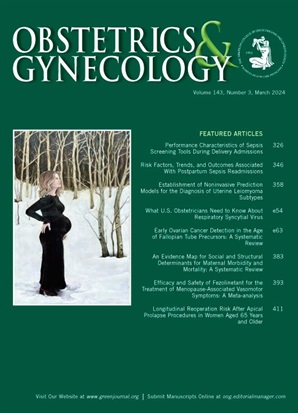复发性尿路感染的临床治疗进展。
IF 4.7
2区 医学
Q1 OBSTETRICS & GYNECOLOGY
引用次数: 0
摘要
尿路感染(uti)在女性中很常见且负担沉重。在这里,我们讨论了我们目前的护理模式所面临的挑战,以及对女性泌尿生殖系统微生物群的不断发展的见解如何提高了我们对如何诊断、治疗和预防非怀孕成年女性复发性尿路感染的理解。传统的护理模式将复发性尿路感染主要归因于胃肠道来源,因此非常强调根除可能过度依赖抗生素的病原体。现在有证据表明,膀胱中有一个复杂的微生物群,泌尿和阴道环境以及膀胱粘膜表面的免疫机制之间的相互作用影响着感染的易感性。因此,在更新的护理模式中,更多的重点放在增强保护性微生物组上。这可能对绝经后妇女尤其重要,她们经历了微生物组的变化,增加了复发性感染的易感性,强调了雌激素治疗和微生物组支持干预的作用。最新的治疗方法强调抗菌药物管理,提倡在安全的情况下确认诊断和延迟使用抗生素,并明智地使用抗生素来缓解症状。预防策略强调阴道雌激素、甲基苯丙胺盐和其他补充剂的重要性,而不是完全依赖预防性抗生素。对诸如尿路感染疫苗和噬菌体药物等新兴疗法的持续研究可能会在未来进一步减少我们对抗生素的依赖。这一临床更新强调了个性化护理计划的必要性,以平衡有效的感染管理,同时最大限度地减少抗生素相关危害,强调了以微生物组为中心的整体方法来预防和治疗复发性尿路感染。本文章由计算机程序翻译,如有差异,请以英文原文为准。
Updates in Clinical Management of Recurrent Urinary Tract Infections.
Urinary tract infections (UTIs) are common and burdensome in women. Here, we discuss challenges with our current models of care and how evolving insights into the female urogenital microbiome have advanced the understanding of how we diagnose, treat, and prevent recurrent UTIs in nonpregnant adult women. Traditional care models attribute recurrent UTIs mainly to gastrointestinal sources, resulting in significant emphasis on eradicating pathogens with potential overreliance on antibiotics. Evidence now shows that the bladder harbors a complex microbiome, with interactions between the urinary and vaginal environments and immune mechanisms at the bladder mucosal surface influencing infection susceptibility. Thus, in updated models of care, more emphasis is placed on enhancing the protective microbiome. This may be especially important in postmenopausal women, who experience microbiome shifts that increase vulnerability to recurrent infections, underscoring the role of estrogen therapy and microbiome-supportive interventions. Updated treatment approaches emphasize antimicrobial stewardship, advocating for confirmation of the diagnosis and delayed antibiotic initiation when safe, and judicious use of antibiotics for symptom relief. Prevention strategies highlight the importance of vaginal estrogen, methenamine salts, and other supplements rather than exclusive reliance on prophylactic antibiotics. Ongoing research into emerging therapies such as UTI vaccines and bacteriophage drugs may further decrease our reliance on antibiotics in the future. This clinical update underscores the need for individualized care plans that balance effective infection management while minimizing antibiotic-related harms, emphasizing a holistic, microbiome-centered approach to recurrent UTI prevention and treatment.
求助全文
通过发布文献求助,成功后即可免费获取论文全文。
去求助
来源期刊

Obstetrics and gynecology
医学-妇产科学
CiteScore
11.10
自引率
4.20%
发文量
867
审稿时长
1 months
期刊介绍:
"Obstetrics & Gynecology," affectionately known as "The Green Journal," is the official publication of the American College of Obstetricians and Gynecologists (ACOG). Since its inception in 1953, the journal has been dedicated to advancing the clinical practice of obstetrics and gynecology, as well as related fields. The journal's mission is to promote excellence in these areas by publishing a diverse range of articles that cover translational and clinical topics.
"Obstetrics & Gynecology" provides a platform for the dissemination of evidence-based research, clinical guidelines, and expert opinions that are essential for the continuous improvement of women's health care. The journal's content is designed to inform and educate obstetricians, gynecologists, and other healthcare professionals, ensuring that they stay abreast of the latest developments and best practices in their field.
 求助内容:
求助内容: 应助结果提醒方式:
应助结果提醒方式:


